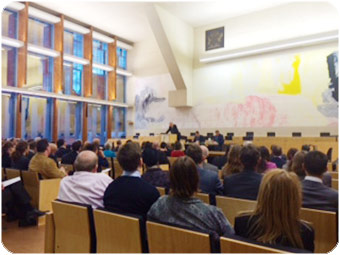Current Legal Issues Seminar Series
Banco Court, Supreme Court of Queensland
8 May 2014
It is a pleasure to have been invited to this Seminar. The pleasure is mixed with terror. One source of pleasure is the company of my good friend Stefan Vogenauer. But he is also a source of terror. For in him you have a world expert. From me you will get only antediluvian prejudices, though they are the prejudices of someone who has read enough statutes to satisfy the needs of a lifetime.
It is a particular pleasure to be speaking in Brisbane — near Ipswich, from which two of the greatest of High Court justices hailed. From one point of view they are the greatest, in view of the unusual problems they experienced.
Sir S amuel Griffith, as first Chief Justice of the High Court, faced two difficulties. The first difficulty was the need to ensure that the High Court gained the respect of State Supreme Court judges. Some of them had opposed the creation of the High Court. They would have preferred that all appeals continued to go, as they had before 1903, straight from Supreme Courts to the Privy Council. In due course the Court, unlike Biblical prophets, did receive honour in its own country. The second difficulty was the need to ensure that the High Court gained the respect of the Privy Council, particularly in constitutional law. This it did, but only after exchanges of hostile fire between Sir Samuel and Lord Halsbury.
amuel Griffith, as first Chief Justice of the High Court, faced two difficulties. The first difficulty was the need to ensure that the High Court gained the respect of State Supreme Court judges. Some of them had opposed the creation of the High Court. They would have preferred that all appeals continued to go, as they had before 1903, straight from Supreme Courts to the Privy Council. In due course the Court, unlike Biblical prophets, did receive honour in its own country. The second difficulty was the need to ensure that the High Court gained the respect of the Privy Council, particularly in constitutional law. This it did, but only after exchanges of hostile fire between Sir Samuel and Lord Halsbury.
Sir Harry Gibbs, on the other hand, faced the unusual difficulties of working out the Court’s best response to the numerous travails through which Justice Murphy had to pass during his last few years on the Court. It is difficult to imagine how anyone could have handled matters better.
The Stature of Mr Justice O’Connor
I want to structure my remarks around the views of one of Sir Samuel’s colleagues — Mr Justice O’Connor, who was, with Griffith CJ and Barton J, one of the three founding justices. For able though Sir Samuel was, Sir Owen Dixon seemed to rate Mr Justice O’Connor more highly. Sir Owen said in 1964 in his address on retiring from the High Court that Griffith CJ had “a dominant legal mind … a legal mind of the Austinian age”.1 Austin’s key doctrine, of course, was that law was a command backed by a sanction — a doctrine which Griffith CJ’s masterful approach to legal problems may not have found unsympathetic. But Sir Owen went on: “I think — speaking for myself — that Mr Justice O’Connor’s work has lived better than that of anybody else of the earlier times”.2 That direct tribute is the more forceful for two reasons. One is that Sir Owen Dixon on that occasion passed on the view of Sir Leo Cussen, though apparently without agreeing with it, that “Barton’s judgments were the best, … they had more philosophy in them, more understanding of what a Constitution was about, more sagacity; … they were well written and … they were extremely good”.3 The other is that praise was a somewhat rare quality in Sir Owen’s brilliant but sombre and rather tart oration. Further, Sir Anthony Mason agreed with Sir Owen Dixon’s view of Mr Justice O’Connor, at least in relation to the foundation justices, for he thought Isaacs J superior in influence and output.4
Mr Justice O’Connor was certainly a formidable figure in our history. He was a member of the New South Wales legislature. He was a key framer of the Constitution. He was leader of the government in the Senate. He was a prominent Catholic in a sectarian age. He was a Fenian in an age of Empire. He was universally respected for his calmness, courtesy and probity. At the end of his relatively short tenure, he was a tragic figure as he tried to struggle though nephritis and worked himself to death — for in those days there was no judicial pension to support his family after his premature demise.
Mr Justice O’Connor’s theories of statutory construction appear to be sound in every way, even now. But before they are explained, it is necessary to indicate the point of view from which this lecture approaches the problem.
 The Central Theme
The Central Theme
The central assumption of this lecture is that judges should construe legislation in order to ascertain what it actually provides, quite independently of their personal opinions about what it ought to have provided.
In jurisdictions influenced by English law, whether they are jurisdictions governed by a written constitution or not, the law is made or declared by judges. Their view of it — what we call “the common law” — prevails unless there is a provision in any applicable constitution, or in any applicable statute, to the contrary. The phenomenon of “judicial activism” is commonly seen as arising mainly in relation to constitutional law or common law.
One problem in a judicially activist approach to a constitution is that constitutions are usually very hard to amend. Hence judicial constructions which are seen as wrong, even badly wrong, can for practical purposes be incapable of correction except by later judges. Our Commonwealth Constitution, of course, is generally seen as very hard to amend by the legislative and popular processes mandated by s 128.
A judicially activist approach to the common law, on the other hand, can be corrected not only by later judges but also by the legislature. But correction can be difficult. Enlisting the aid of the legislature can sometimes be very hard. And the practice of ultimate appellate courts is to abstain from altering what prior authorities have decided unless they are thought to be not only plainly wrong but also productive of serious inconvenience.
Yet judicial activism can be as great a problem in relation to non-constitutional statutes as it is with constitutions and the common law. That is because statutes have no accepted meaning until the courts have construed them. Of course both the human agents of the government, and the governed themselves, have to act on what they take to be the statutory meaning even before any curial construction has taken place. In many instances what they understand to be the meaning is confirmed in due course by the courts. But this is not always so.
The courts, in other words, play an mediatory role between the governor — the legislature, the lawgiver, the commander — and the governed, to whom the laws are given. That mediatory role is in fact very great. Its significance is accentuated by the increasing number and range of statutes nowadays — what Lord Bingham of Cornhill unflatteringly called the “legislative hyperactivity”5 of the modern scene. Let us remember Bishop Hoadly’s sermon preached before King George I on 31 March 1717. The King probably did not understand it, having not long before arrived from Hanover, but in it Bishop Hoadly used words the fame of which is well deserved:
“Whoever hath an absolute authority to interpret any written or spoken laws, it is he who is truly the lawgiver, to all intents and purposes, and not the person who first wrote or spoke them.”
And of course our courts have an absolute authority to interpret all written or spoken laws. At the end of the day, the only relevant role in interpreting legislation is that of the courts. The interpretation of legislation is what the courts say it is. People may disagree with a particular interpretation. But they are bound by that interpretation. That is so whether they are legislators, officials or members of the public. There is no sanctuary in which the governed — or indeed the government — can hide away from the consequences of the interpretation. Nothing can be done about an inconvenient interpretation until some fresh step is taken — a change of mind in the courts or a new statute. That remains the case however much the interpretation rejected by the courts is favoured by the public, however much it is unanimously supported by governing elites, or however much it was carefully framed by those advising the executive and the legislature when the legislation was being prepared.
There are abuses, or risks of abuse, inherent in what Bishop Hoadly called “an absolute authority to interpret” the laws. For this “absolute authority” which the judiciary possesses gives it immense power in relation to statutes. You all know the trenchant phrases of Lord Acton which he used to Bishop Mandell Creighton about the latter’s History of the Popes. On 3 April 1887, he wrote a letter to Creighton to complain about the book’s failure to condemn the failings of the medieval papacy more vigorously. He said: “Power tends to corrupt and absolute power corrupts absolutely. Great men are almost always bad men.” Perhaps “greatness” is an expression which it is not appropriate to apply to judges. But if it is, there are, no doubt, some great judges — or judges who have been called great — who have been corrupted by power and who became bad men.
How far can principles of statutory construction control these risks of abuse and corruption? How far do the principles of statutory construction increase those risks?
Click here to download full article
Click here to download the handout
J D Heydon




 amuel Griffith, as first Chief Justice of the High Court, faced two difficulties. The first difficulty was the need to ensure that the High Court gained the respect of State Supreme Court judges. Some of them had opposed the creation of the High Court. They would have preferred that all appeals continued to go, as they had before 1903, straight from Supreme Courts to the Privy Council. In due course the Court, unlike Biblical prophets, did receive honour in its own country. The second difficulty was the need to ensure that the High Court gained the respect of the Privy Council, particularly in constitutional law. This it did, but only after exchanges of hostile fire between Sir Samuel and Lord Halsbury.
amuel Griffith, as first Chief Justice of the High Court, faced two difficulties. The first difficulty was the need to ensure that the High Court gained the respect of State Supreme Court judges. Some of them had opposed the creation of the High Court. They would have preferred that all appeals continued to go, as they had before 1903, straight from Supreme Courts to the Privy Council. In due course the Court, unlike Biblical prophets, did receive honour in its own country. The second difficulty was the need to ensure that the High Court gained the respect of the Privy Council, particularly in constitutional law. This it did, but only after exchanges of hostile fire between Sir Samuel and Lord Halsbury. The Central Theme
The Central Theme